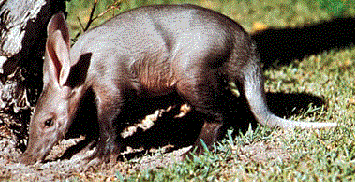

Family Orycteropodidae
(aardvark)
Aardvarks are pig-sized mammals (up to 82 kg) that specialize in insectivory, especially in capturing and consuming termites. Their limbs are modified for digging into the very hard termite mounds found in African savannahs. The nails are actually somewhere between true nail and hoof in form. They are strongly constructed, shovel-like, and obviously adapted for digging. Aardvark skin is thick and sparsely haired. The thickness of the skin protects these animals from biting ants, and aardvarks may sleep in the ant nests they have recently excavated for feeding.
The skulls of aardvarks are elongate and conical, and aardvarks have a more elaborate set of turbinal bones than any other mammal. The zygomatic arch is complete. The palate ends at the posterior end of the palatine bones; it is not extended posteriorly by the pterygoids (as is the case in pangolins).
While aardvarks have teeth (unlike other anteaters), they lack incisors and canines (dental formula 0/0 0/0 2-3/2 3/3 = 20-22). No enamel is present on their cheek teeth, which are made up of hexagonal prisms of dentine that can be seen under a dissecting microscope. These teeth are, however, surrounded by a layer of cementum. They are rootless and continuously growing. The dentition of aardvarks is also unusual because, while they are diphyodont, the milk teeth are small, variable in number, and shed before the animal is born.
Like pangolins, aardvarks have a long, protrusile tongue and a gizzard-like stomach. They seem to rely primarily on their sense of smell for locating prey. Their nostrils have peculiar fleshy tentacles and dense hairs; these serve to seal the nostrils when the animal is digging.
Aardvarks were once thought to be closely related to pangolins and xenarthrans. We now think that their resemblance to members of those groups is a result of convergent adaptation for eating ants, and that their real affinities lie with the Sirenia, Hyracoidea, and Proboscidea. Their fossil record is scanty; it begins in the early Miocene (a few older fossils have been questionably associated with this group).
There is one Family (Orycteropodidae) and one species (Orycteropus afer) in this order, making this the smallest order of mammals. Aardvarks are found in Africa south of the Sahara.
<<<<<<<>>>>>>> ARTIODACTYLA CARNIVORA CETACEA CHIROPTERA DASYUROMORPHIA DERMOPTERA DIDELPHIMORPHI DIPROTODONTIA HYRACOIDEA INSECTIVORA LAGOMORPHA MACROSCELIDEA MICROBIOTHERIA MONOTREMATA NOTORYCTEMORPHIA PAUCITUBERCULATA PERAMELEMORPHIA PERISSODACTYLA PHOLIDOTA PRIMATES PROBOSCIDEA RODENTIA SCANDENTIA SIRENIA TUBULIDENTATA XENARTHRA
Email: eradani7@aol.com